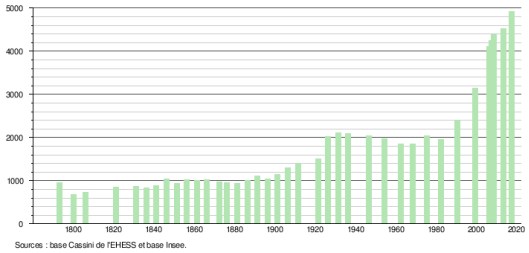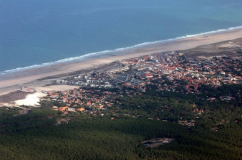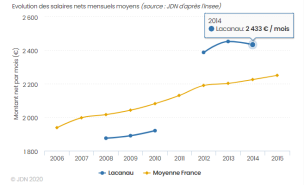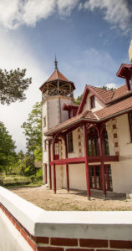Lacanau, Gironde, Nouvelle-Aquitaine 作者: 来源: 发布时间:2021-09-25
I.Population and Area
Total Area: 214, 02 km2
Population in 2017: 4 914
Population Density: 23 /km2
Histogram of demographic change

II.Natural Geography (environment and resources)

Lacanau is a town in southwestern France located in the Gironde department, in the Nouvelle-Aquitaine region.
In Occitan Gascon the city is called La Canau.
The municipality of Lacanau is part of the community of municipalities Médoc Atlantique.
Bordering the Atlantic Ocean, Lacanau is a seaside resort where a major surfing competition, the Lacanau Pro, takes place every year.
Geography:
The commune of Lacanau, crossed by the 45th parallel north, is therefore located at an equal distance from the North Pole and the terrestrial equator (approximately 5,000 km).
Location:
Lacanau is located on the edge of the Atlantic Ocean, in the Medoc, to the west of the Gironde department, 42 kilometers north-west of Bordeaux.
Neighboring and bordering municipalities
The nearest towns are Saumos (10 km), Carcans (12 km), Le Porge (12 km), Le Temple (13 km), Brach (13 km), Sainte-Hélène (16 km), Salaunes (20 km ), Lège-Cap-Ferret (21 km), Castelnau-de-Médoc (23 km) and Hourtin (23 km).
The municipality has an area of nearly 214 km2 (21,402 hectares) and its altitude varies from 0 to 66 meters3.
Located on the Silver Coast, Lacanau is part of the Landes du Médoc, part of the Landes de Gascogne. There are three natural areas:
the beach and the dune cordon (Côte d'Argent);
the Landes forest (Landes du Médoc) which, unlike the rest of Landes Gascony, did not come from the intensive afforestation of the nineteenth century;
Lake Lacanau, one of the great Landaisa lakes.
Open to the open sea by the Bay of Biscay, the ocean coast of the Medoc offers a line of more than 100 km of a beach made of fine sand. The north-northeast, south-southwest orientation is perpendicular to the action of the swells, mainly from the west (77%) and northwest (20%). The coast is rather inhospitable due to the violence of the ocean with its big rollers, but also to the destructive effects of winter storms. An ancient phenomenon, the decline of the coastline continues and, despite human intervention from the nineteenth century, the coast remains faced with the recurring problem of marine erosion.
During the winter of 2013-2014, the Aquitaine coast suffered significant damage and retreated 10 meters under the effect of storms. In Lacanau-Océan, hit by storms combined with high tides, the seafront suffered a sharp decline despite the anti-erosion protection. The wall serving as protection against erosion collapsed and the wooden stairs leading to the beach were destroyed.
Following major stonework and the restructuring of access to the beach, Lacanau-Océan regains all its appeal before the storms of 2014.
There is also the pond of Cousseau. Located in the town, it covers an area of 50 hectares, and is part of the national nature reserve of the pond of Cousseau. This reserve was created in 1976 (RNN), and covers 600 hectares. It is home to many animal and plant species from various environments. The nature reserve shelters in particular the last specimens of Landes sea cows. Today, the SEPANSO association is in charge. It is possible to visit this reserve, accompanied by a guide.
Weather
The climate of the Gironde is of the Aquitaine oceanic type, the winters are mild thanks to the proximity of the ocean and the summers hot and stormy. Rainfall in Lacanau is higher than in the rest of the department due to its proximity to the coast.
The summer being hot and particularly dry, Lacanau is regularly subject to fires. In August 2012, 650 hectares of forests burned15. At the end of 1948 there were already defense and observation points in the Gironde. The following year around fifty fires devastated more than 50,000 hectaresa.
Communication routes and transport
Lacanau is served by several lines of the TransGironde bus network (Gironde interurban network):
line 702, connecting Bordeaux-Saint-Jean station to Lacanau ocean
line 611 which joins Lège-Cap-Ferret only during the months of July-August
line 714 connecting Lacanau-Océan to Lacanau-Ville only during the months of July-August.
III.ECONOMY
Employment rate (%): 74.4 (2017)
Poverty rate by age group of the tax advisor(%): 11 (2017)
Average employment income (€):2 433 net per month (29 190 net per year)(2014)

Evolution of average monthly net wages
Sources : http://www.journaldunet.com/business/salaire/lacanau/ville-33214
https://www.insee.fr/fr/statistiques/2011101?geo=COM-33214
IV.Industrial Characterisitics
Economical fabric
At the end of 2010, Lacanau had 888 establishments of which 6.5% were in the agricultural sector (for an average of 13% in the department) and 73.3% in that of trade and services (for 58% in the department) and 8.2% from the administration and health sector. In 2012, out of 1,183 establishments in the town, 8% were in the agricultural sector (for an average of 11% in the department), 2% in the industry sector, 8% in the construction sector, 74% of that of trade and services (for 61% in the department) and 8% of the administration and health sector.
The economy is largely turned towards summer tourism. In addition to its beach and its six equipped bathing areas, the town has a casino, golf courses, water sports areas, tennis courts, etc.
Appellations on the territory
Several AOCs (Controlled Designation of Origin) exist on the territory: IGP Agneau de Pauillac, IGP Asparges des sables des Landes, IGP Bœuf de Bazas, IGP Duck with foie gras from the South-West, IGP Jambon de Bayonne, IGP Poultry from the Landes .
Tourism
The Médoc Océan tourist office is responsible for organizing and promoting tourism in the territory of Lacanau, Carcans and Hourtin.
V.Attractions
1.The Maison du Commandant in Moutchic

The Maison du Commandant in Moutchic, an emblematic site of Canaulese history and an architectural gem, this building has regained all its brilliance in its green setting after major recent restoration work.
2.The old town hall and the school
Saint-Vincent Church, which celebrated its 250th anniversary in 2017, has also been restored in recent years and enhanced at the entrance to the City.
Sources : https://www.lacanau.fr/lacanau/histoire-et-patrimoine-de-lacanau/
VI.History
In the 18th century, in 1764-1765, a new church was built, the old one initially located 500 m east of the current shore of the lake having been covered by the sands and waters of the pond because the construction of 'a dike was not enough to block the advance of the marshes. The town, a neighboring territory of the sea, is exposed to changes in its terrain either by the supply of sand from the ocean, whose wind then forms dunes, or by rainwater, which does not flow , form ponds. Agricultural activities are developing around the cultivation of pines, which also makes it possible to fix the mobility of the sands, and of fishing. The economy of the town before the twentieth century is organized around the agro-pastoral system and the exploitation of resin.
The train arrived very early in Lacanau in the nineteenth century, the railways setting out to conquer the Atlantic. In 1824, the canal was dug connecting the lakes of Lacanau, Porge and Lège. The dunes were not stationary until their 18th century afforestation. The establishment of the coastal dunes dates from the beginning of the nineteenth century (November, year XI), where 37,000 hectares are sown.
In 1884, Pierre Ortal, owner in Lacanau and head of the Landes Railways department, informed the municipality of Lacanau in writing of his intention to create a seaside resort on the coastal dunes of the municipality. The municipal council of October 5, 1884 studied the preliminary draft of a railway of local interest submitted by Pierre Ortal to extend the future line from Bordeaux-Saint-Louis to Lacanau (opened in 1885), with a view to creating this station seaside. To get there, Pierre Ortal and silver notables from the Bordeaux region founded in 1890 the Société immobilière de Lacanau et du chemin de fer de Lacanau à l'Océan. The main shareholders will be Émile Faugère, engineer, Albert Lagueyte, Jean Bonnamy, entrepreneurs, and Pierre Durand, the architect. As informed and visionary men, they acquired land from the Domaine de Lacanau and proceeded in an exchange with the State, in 1900, for some 380 ha located on the coastal dunes of the municipality of Lacanau. The plan of the subdivision was drawn up by Pierre Durand and Jean Bonnamy, in 1903. In addition, Émile Faugère, engineer specializing in the construction of railway tracks, presented to the authorities, on August 19, 1903, the plan of the future railway track. so-called "local interest" railway that can link Lacanau to the ocean. In October 1904, the first land put up for sale will be marketed. Construction materials could be transported as early as 1905, the railway line and the Lacanau-Océan station having been put into serviceb 2.
A seaside resort since the beginning of the 20th century, Lacanau-Océan celebrated its centenary in 2006.
Villas emerge from the sands and will be completed for the most part in 1906-1907: in particular La Primavera, the villa of the founder of the resort, Pierre Ortal, unfortunately destroyed at the end of the 1970s. In its place, a modern building was erected. , which is not the ugliest of those built in those years, but that is little consolation; the Bonnamy chalet (the current hotel on the Silver Coast) and the Princeteau family's villa les Mouettes, all three having been the first to be built on Boulevard de la Plage. At the same time, the villa les Genêts and the hotel Marian (the current Australian) were built on the avenue de la plage (the current allées Ortal), Beau Site by Jean Émile Faugère, the most beautiful residence of the resort that the descendants of this man always invest in summer and the villa PH alias Plaisance of the architect Pierre Durand that the municipality of Lacanau is restoring.
In 1910 the road linking Lacanau to Lacanau-Océan33 was inaugurated. Following the development of the automobile, the railway lines closed from 1949b 2.
During World War I, American soldiers set up a seaplane base and a flight school in Moutchic, which later became a sanatorium and then a medical and educational center34.
In August 1937, the Cantabria, a Spanish ship carrying Spanish travelers fleeing the Franco dictatorship, ran aground on the beaches of the Alexander at Lacanau34,35.
Lacanau has been hosting a world surfing championship event every August since 1979, the Lacanau Proa 4. The oldest surf club in Europe is the Lacanau Surf Club, created in 1968.
VII.Other information
LUDO-MEDIA: CLICK & COLLECT
The toy library is no longer open to the public but is organizing a "Click and Collect" collection service this week at the following times:
City: Tuesday and Thursday from 3 p.m. to 6.30 p.m.
Ocean: Wednesday and Friday from 2 p.m. to 5 p.m.
You can make your reservations either directly on our site http://ludomediatheque.lacanau.fr/, or by phone (05 57 17 08 10), or by email (ludo-mediatheque@lacanau.fr).
The toy library team will contact you as soon as your order is ready to make an appointment.
You will then come with your own bag and of course your mask.
CONTACT
• City: Tuesday and Thursday from 3 p.m. to 6.30 p.m.
• Ocean: Wednesday and Friday from 2 p.m. to 5 p.m.
You can make your reservations either directly on our site http://ludomediatheque.lacanau.fr/
either by phone: 05 57 17 08 10
or by email ludo-mediatheque@lacanau.fr
Cultural events and festivities
The Lacanau Pro is a great surfing competition that takes place every year in Lacanau. It is part of the circuit allowing to participate in the world surfing championships.
NEW BEACH PLANS
TWO PRIORITY SITES IN LACANAU
Between 2015 and 2016, a study was carried out by the former Communauté de Communes des Lacs Médocains with the support of the GIP Littoral Aquitain on the redevelopment of beach plans. Indeed, the aging of equipment, the problem of erosion on oceanic beaches, the observation of increasing attendance make it imperative to reorganize the Medoc Beach Plans in an overall and shared vision of the territory and the 13 sites in the region. 'study.
After having drawn up a synthetic portrait of the 13 ocean and lake beach plans based on an inventory-diagnostic carried out by the GIP Littoral Aquitain and the mobility-travel study carried out by the INDDIGO design office, the study retained 5 sites for which redevelopment was a priority, including 2 located in Lacanau: the Super Sud beach and the Moutchic site.
In the second phase, the study led to the definition of an overall development program for each of the 5 sites selected, governed by common development logics such as:
adapt to erosion
preserve environments
size a parking offer adapted to seasonal operation
optimize beach safety
intensify the service offer
create signage for Médoc beaches ...
Following the study, an in-depth study was carried out on the two Canal beaches:
The Super Sud Beach Plan was piloted by the National Forestry Office (ONF) with the Medoc Atlantique Community.
After carrying out pre-operational studies and consulting companies, work will start this fall 2019.
The Moutchic site was the subject of an additional study, delivered at the end of 2017.
A programming study will be launched in 2020 to consider starting work at the end of 2020-beginning of 2021.
The redevelopment of Plans Plages de Lacanau is the subject of close consultation with the GIP Littoral, the Medoc Atlantique community of municipalities (which has been responsible since 2018), the Gironde Department, the National Forestry Office. (ONF) and the Nouvelle-Aquitaine Region.
The inhabitants are also involved in the projects. The redevelopment project of the Plan Plage de la Super Sud was thus presented to the Ocean District Council in April 2018.
SUPER SUD BEACH PLAN - LE LION
A large oceanic site, the southern sector of Lacanau extends from the southern beach to the south of the lion parking lot. This is a natural beach plan, very little equipped, offering a good parking capacity under the pine forest.
Due to the gradual disappearance of bathing functions on the central beach of Lacanau, due to the general problem of erosion, it is necessary to anticipate the future postponement of frequentation on the south and south south (or super south) beaches. accessible from the Lion car park.
It is also a matter of giving more space to pedestrians and bicycles, of protecting the dune environment and the protective forest, of providing the few necessary equipment for users to preserve the site from any nuisance.
Following the public inquiry opened from July 15 to August 16, 2019, the investigating commissioner submitted his investigation report and his conclusions on this project, which are favorable. The report is made available to anyone interested until August 16, 2020 inclusive at the town hall.
Circulate more easily
Travel will be improved up to Lion Beach: for vehicles, the car parks will be more accessible and their capacities will be increased. Shuttle stops will also be set up.
For pedestrians and bicycles, better signage will make their routes safer. A dedicated pedestrian path will be created from north to south of the car park (i.e. 1.4 km). A connection of pedestrian, bicycle and vehicle flows to a future "south beach - resort center" axis will be planned for the future.
At La Forestière, at the entrance to the site, a real reception center will be set up: toilets, showers, shuttle stop, bicycle park and new parking lot with 220 spaces. Sanitary facilities will also be created at Lion Beach and the site's reception furniture (tables and benches, signage, gantries, bicycle park) will be renovated.
Simulation
© Landira, BELONF
Protect the environment
In order to better protect and restore natural environments, the laying of branches on the sand, the installation of windbreak nets and the planting of marigolds will be carried out. To limit the impact of tourist activity on the environment, pedestrian flows will be channeled through 3 main accesses: the Forestière in the North, the Sauvageonne in the middle and the Lion in the South. These accesses to the North and the South will be remodeled.
The project requires an investment of around one million euros. It is co-funded by the State, the Medoc Atlantique Community of Communes, the Nouvelle-Aquitaine Region, the Gironde Department and the ONF. It is subsidized at 75%.
THE MOUTCHIC BEACH PLAN
This lakeside site is experiencing a constantly increasing number of visitors which invites us to think about its re-organization within a beach plan.
One of the objectives of this Moutchic beach plan is to preserve its "village spirit" and its image appreciated by families.
Managing and securing automobile, pedestrian and cyclist flows has been identified as one of the major axes of this beach plan, with the encouragement of soft links. Thus, the avenue de la plage will be reconfigured to give the beach back to pedestrians and cyclists via a lakeside dock while maintaining the current road for cars.
This plan also focuses on improving parking, beach access, and increasing equipment. Several actions around signage and management of nautical activities are also planned. The landscape integration of the site, the strengthening of the place of plants, the choice of materials in accordance with the natural atmosphere of the place, the preservation of the banks and the awareness of the public to the fragility of aquatic environments are all actions that will be implemented in this beach plan.
Sources: https://www.lacanau.fr/ma-mairie-en-action/les-grands-projets/nouveaux-plans-plage/
VIII.Contact information
Lacanau town hall address :
31, Avenue de la Liberation
33680 Lacanau France
Mayor : Laurent PEYRONDET
Mail: mairie@canejan.fr
Phone number: 33 (0)5 56 03 83 03
Website : https://www.lacanau.fr/
Sources : https://www.lacanau.fr/
